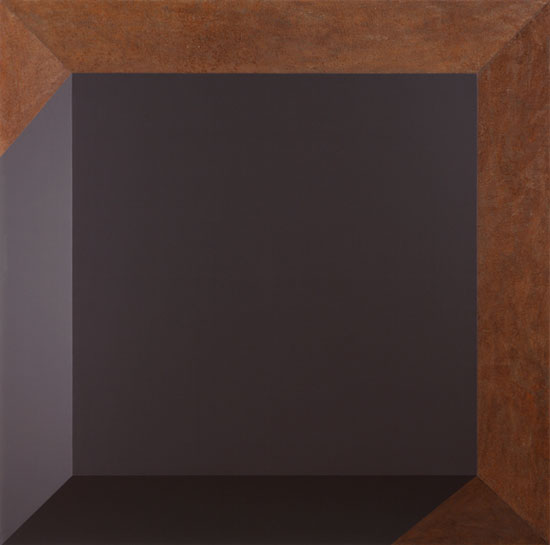Wolfram Ullrich
Cube, 2005
Acrylic on rusted steel
138,5 x 138,5 x 16 cm
© Artist
Photo: Gerhard Sauer
A cube is a cube. A die is a die. Or so we might think. But it is clear that we cannot view even a comparatively simple object like a cube as a whole, but only in perspective. All we can see are at most three faces and nine edges of a cube – and yet we are certain in our minds that this is a cube. This brings us to a central issue that has concerned phenomenology ever since Edmund Husserl. The question among others is whether, and if so with what right, our knowledge completes our sensory experience and in that way contributes to the very success of perception.
In the case of Wolfram Ullrich’s »Cube«, this perception simply does not succeed. Neither by simply looking, nor by consulting our knowledge. If one stands flat-on in front of the picture, one sees a square in a kind of passe-partout. On the lower left margin, two grey surfaces make sure that we recognize this as a cube in parallel perspective. Only when we change our focus does the semblance of a cube fall apart, and the arrangement reveals itself to be a relief.
Wolfram Ullrich’s works operate within the rules of concrete constructive art, but their stimulus goes far beyond. Already while he is at work, the artist assumes the position of the viewer, and anticipates as it were the consequences that the work’s aesthetic reception will have on his artistic practice. Formally clear and seductively to the point, as Ullrich emphasizes: »The formal rigour and clarity of the works is necessary in order to allow the viewer the chance to perceive this as an open field of work and reception.« This artistic approach is an essential precondition which ensures that a quick glimpse and nod of agreement will always prove unsuccessful with Ullrich’s works. Instead the artist keeps his audience in constant movement through the fluctuation he presents between reality and appearances, knowledge and perception. The cube is there, and not there. The opaque surface of the rusted steel appears constantly to change its angle of inclination. The work’s form, colour and dimensions can scarcely be grasped – at most they can be approximately determined with every new angle the beholder assumes. (Ralf Christofori)
Wolfram Ullrich
1961 born in Würzburg
Lives and works in Stuttgart


